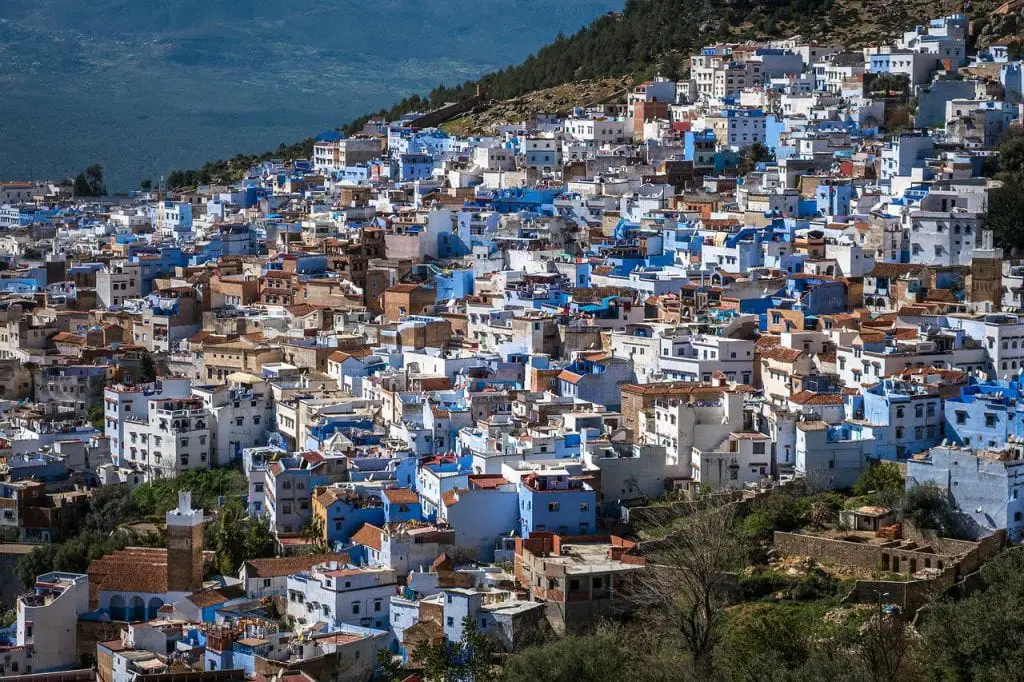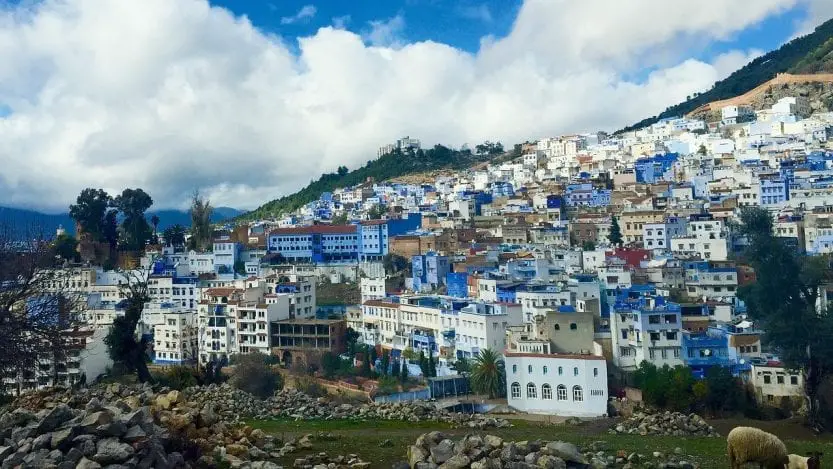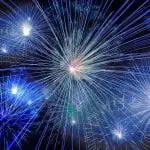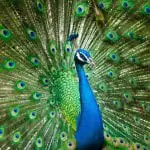A country that has been shaped by multiple cultures and traditions that have ruled over the land over the centuries, Morocco is truly legendary. It is a cultural hotspot that has a rich recess of history and tradition. It is also a country that is known for its beautiful cities and astounding architecture. A country of diverse landscapes, Morocco is home to waterfalls, deserts, landscapes, and beaches. It is truly a country that has been created by the Gods. Amongst the many incredible cities that Morocco has, is one that is known as Chefchaouen.
It is known to most as the ‘bluest city’ that the world has ever seen. Chefchaouen might not be as dreamy as Casablanca or as oriental as Merekkesh, but it would be a crime to call it any less beautiful. Having a rich history, this small city in Morocco is housed within the Rif Mountains and boasts of archaic and incredible architecture and surroundings. However, the most striking feature of this city has to be the incredible array of blue objects that can be found in almost every street of this quaint city.

In this article, you will be able to learn more about the rich history of Chefchaouen and learn about the reasons that make it the bluest city in the world. It is not just coincidence that has filled the entire city with blue objects. Logical reasoning and in some cases the influence of faith and the many cultures have helped shape this beautiful city. They also have an impact on the blue color the city dons. So without further ado, let’s delve into the reasons that make Chefchaouen blue.
History of Chefchaouen
Moulay Ali Ibn Rashid Ali Alami of Muhammad Al-Alami’s dynasty helped form the city of Chefchaouen. It was originally built as a kasbah or a fortress city. It was a means to repel the Portuguese invasions that were taking place in the Northern borders of Morocco. The founding dates of the city of Chefchaouen can be traced back to 1471. While the Ghamora tribes originally populated the region, it was soon occupied by migrant Jews and Moriscos who fled from Spain during the Spanish Reconquista.
However, despite the city being a refuge for persecuted migrants who fled from the Spanish during the medieval times, Spain successfully occupied the city post the creation of the Spanish Protectorate in the country of Morocco. The following years were full of tension and war, with the Spanish army retreating from the city as Abd el-Krim el-Khattabi creating the Republic of Rif between 1924-26. The Rif War soon followed, when Chefchaouen was even bombarded by rogue American pilots, leading to the death of several civilians. It was reclaimed by the Spanish Army after al-Khattabi got deported by the French to Réunion. However, in 1958 Morocco finally declared itself to be independent and Chefchaouen was welcomed back with open arts into the dominions of independent Morocco.
All of these historic shifts in rulership, the many trials and tribulations that the country has undergone helped shape what we know today as Chefchaouen. Unless all of these cultural influences had happened over time, the city would not have such a rich history or heritage to boast of in the modern-day. Therefore, apart from the scientific reasons that have influenced Chefchaouen to be filled with blue objects its history also plays an integral role. The same can be said about the background of Chefchaouen, which has been elaborated upon in the following section.
Background of Chefchaouen
One of the major reasons that Chefchaouen is as blue as it is is for creating a never-seen-before attraction that beckons tourists. However, its proximity to Ceuta and Tangier are two other reasons that make this Moroccan city a hotspot for tourists. With as many as two-hundred hotels in the city, it is adeptly capable of housing and catering to tourists that visit the city. One of the most striking features of these hotels is the fact that they are rinsed in blue.
This blue city is a strange yet alluring destination that offers visitors incredible markets or bazaars to shop from. It also offers them with delicious local delicacies like goat cheese. Kief is another major attraction that Chefchaouen holds, with many tourists indulging in the intoxication of this cannabis byproduct. Chefchaouen happens to be one of the major producers of the plant in Morocco.
There are many theories as to what makes the city of Chefchaouen filled with blue objects and walls. It is also quite a surreal sight that makes for an incredible visual treat. In the following segment of this article, the truth and reason behind the blue demeanor of the city of Chefchaouen will be delved upon.
Reasons that make Chefchaouen blue
As has been elaborated above, one of the most eye-catching features about the city of Chefchaouen, or Chaouen, as it is called by the locals, is the different shades of blue that adorn the city. The striking blue can be found in varying shades and degrees all over the city and there are many theories claiming why these blue objects have dominated the landscape of this area. While some refer the reason to be of practical nature, others leave it to be based upon history or faith. However, if you have to truly decipher the reasons for what makes Chefchaouen blue, you would need to consider all of these reasons, as there is some truth to all of them.
Jews
Jews believe that all things that are blue are representations of the heaven and sky. It is a common practice in Jewish communities to paint materials and objects in the colors of blue to make them signify the sky. This color can be found in various objects that can be found in the Jewish communities, with the most notable material being Jewish prayer mats.
It is believed by some people that this fever of decking the entirety of Chefchaouen with blue objects was encouraged by the Jews back in 1930. It was first started by them with their own houses and later spread to the entire city as a means of staying true to their religious beliefs. Older residents who have been living in Chefchaouen for decades claim that most of the city used to be decked with white buildings and the blue-colored buildings are a recent change that the city has experienced.
Mosquitoes
The next reason that has been attributed to the city of Chefchaouen being filled with blue objects and buildings is that the color blue apparently helps repel mosquitoes. The residents saw that the Jewish part of the town, which had most of its buildings painted blue, had lesser mosquitoes compared to the rest of the city. Therefore, the other inhabitants of Chefchaouen decided to color their houses blue as well. Apparently, mosquitoes do not like being in the water, as do most insects and the blue walls of the buildings look a lot like flowing water. Therefore, mistaking these walls to be water, mosquitoes tend to stay away.
A homage to the Mediterranean Sea/ Ras el-Maa Waterfall
The next reason that justifies the city building and walls of Chefchaouen being blue is that it is apparently an homage to the Mediterranean Sea. However, others debate that the blue is not representative of the Mediterranean Sea at all, but reminisces the Ras el-Maa Waterfall, which provides the entire city of Chefchaouen with its drinking water. The blue color is representative of the fact that they have been given the gift of sustaining life by these forces of nature in an environment that is otherwise hostile.
Heat
Chefchaouen is located in a hot and arid region and some groups of locals suggest that the color blue adorns their walls as a heat repellent. Apparently, the blue color allows them to keep their homes cool during the scorching heat of the summer. Although it might not be the original reason for the city being painted blue, it is quite scientific and makes sense in modern times.
Aesthetics
Islam attributes the color blue to feelings of optimism and happiness. Moreover, there is no denying the fact that having blue-colored walls makes Chefchaouen incredibly unique and beautiful to look at. Therefore, considering the fact that the city has been painted blue to add to its aesthetic beauty is not a bizarre idea to have at all.
Tourism
During the Catholic feasts of Christmas and Semana Santa, the city of Chefchaouen is overrun with huge crowds of tourists, especially those coming from Spain. Amongst other things that attract tourists to the beautiful city of Chefchaouen, the blue-colored walls are definitely an important aspect. With the growing tourism industry and the prevalence of Morocco as a tourism hotspot in the world map, being the bluest city in the world definitely helps Chefchaouen make its mark.
There might be many different original reasons for filling up Chefchaouen with blue objects. However, it cannot be denied that this aspect lends the city with an aura of mystique that benefits the city in modern times. Being a photographer’s heaven, along with the many riches of culture, tradition, cuisine, and history that Chefchaouen has to offer, the blue color of the city just serves as the cherry on top.



